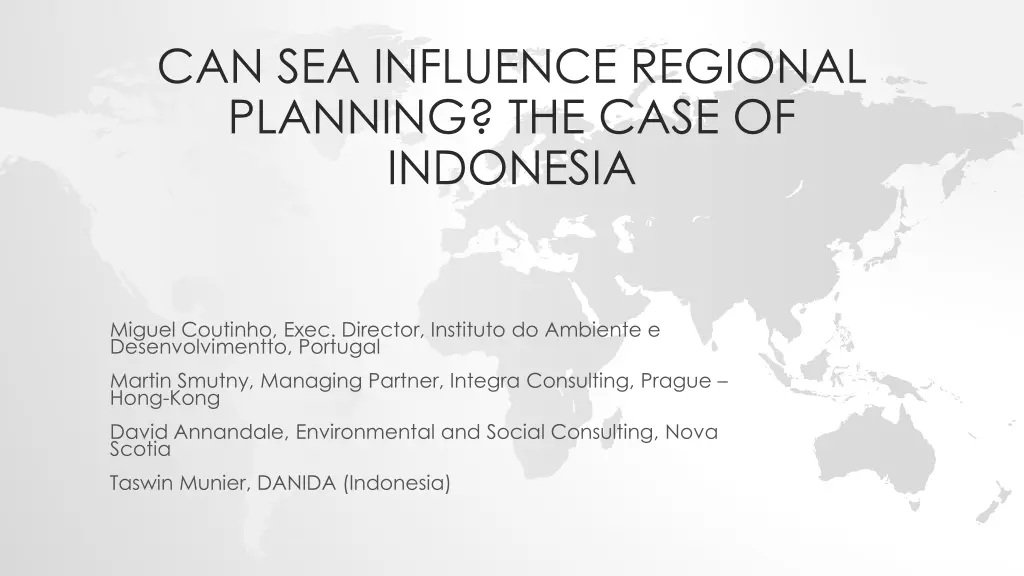
Sea Influence on Regional Planning in Indonesia
Explore the impact of Strategic Environmental Assessment (SEA) on regional planning in Indonesia, focusing on the DANIDA project's efforts and lessons learned. Discover the regulatory advancements in SEA, the objectives of the recent DANIDA project, and the approach taken to evaluate SEA effectiveness in influencing regional development plans.
Download Presentation

Please find below an Image/Link to download the presentation.
The content on the website is provided AS IS for your information and personal use only. It may not be sold, licensed, or shared on other websites without obtaining consent from the author. If you encounter any issues during the download, it is possible that the publisher has removed the file from their server.
You are allowed to download the files provided on this website for personal or commercial use, subject to the condition that they are used lawfully. All files are the property of their respective owners.
The content on the website is provided AS IS for your information and personal use only. It may not be sold, licensed, or shared on other websites without obtaining consent from the author.
E N D
Presentation Transcript
CAN SEA INFLUENCE REGIONAL PLANNING? THE CASE OF INDONESIA Miguel Coutinho, Exec. Director, Instituto do Ambiente e Desenvolvimentto, Portugal Martin Smutny, Managing Partner, Integra Consulting, Prague Hong-Kong David Annandale, Environmental and Social Consulting, Nova Scotia Taswin Munier, DANIDA (Indonesia)
OUTLINE Background to regional planning and SEA in Indonesia. What has the DANIDA project attempted to achieve? Lessons learned
BACKGROUND Steady strides in the development of a SEA regulatory structure over the last 5 to 10 years. With the assistance of donors, and especially DANIDA, SEA has increasingly been put into practice, with many large-scale pilot projects in different sectors now acting as examples for future practice. In recent years, attention has moved to the role that SEA can play in mainstreaming environmental issues into national, regional, and local socio-economic planning. Upwards of 30 SEAs have been undertaken at different scales of planning. Over 150 SEAs have been carried out in the last 10 years.
WHAT HAS THIS MOST RECENT DANIDA PROJECT ATTEMPTED TO ACHIEVE? The project was associated with implementation of the 2012 Regulation 67 (Guidelines on the Implementation of Strategic Environmental Assessment in the Preparation of Evaluation of Regional Development Plans). Two separate consulting contracts, each focused on three regional plans in Bali, Sulawesi, and East Kalimantan. The next slide gives an idea of the geographic extent of Districts. The aim was to assist with the production of SEA documentation and coordination of SEA procedure, and to analyze the effectiveness, or otherwise, of the SEA processes.
WHAT APPROACH DID WE TAKE? We wanted to identify positive and negative aspects of the SEA work, so as to provide documentation for replication of SEA in other Districts. Comparison of SEA performance across the Districts, using a consistent set of criteria. To what extent did SEA actually influenced the production of each Regional Development Plan (RPJMD)? Comparison criteria followed the required SEA process as enumerated in Regulation 67:
WHAT APPROACH DID WE TAKE? formation of Working Groups; preparing Terms of Reference; pre-scoping; scoping; baseline; assessment; mitigation and recommendations; stakeholder engagement; and, financing. Note that these criteria focus largely in procedural aspects rather than on the substance as to whether the SEA has contributed to a better Plan.
WHAT PROCESS WAS USED IN THE DEVELOPMENT OF THE SEAS? Multi-agency SEA Working Groups established in each District. Separate group established to develop the Regional Plans. Regulation 67 requires that there be a formal recognition of the outcomes of SEA, and that the results should be reflected in the design of the Regional Plan.
OUTCOMES AND LESSONS LEARNED Positive In most cases, recommendations made in the SEAs were formally taken into account in the final drafting of the Regional Plans. In most cases, SEA studies took place in parallel with the drafting of the Regional Plans. In at least one case, a formal Integration Plan was agreed on. SEA Working Group members were sometimes also members of the Regional Plan drafting group. The Working Groups were formally established by the Heads of the Regional Governments. SEA Taskforces in Berau and Gorontalo also function during RPJMD implementation and coordinate monitoring and evaluation of implementation of the SEA recommendations.
OUTCOMES AND LESSONS LEARNED Not-so-positive Iack of SEA experience in the Working Groups, and some inter- agency ego-tussling. Lack of baseline data. High-level nature of proposed programmes sometimes meant that identifiable impacts were ignored. One result is vague and overly general mitigation measures. How to weight sustainable development issues? NGO involvement? Very limited time for carrying out entire SEA process as RPJMD has to be drafted and submitted for adoption six months after elections.
FINAL REFLECTIONS Evaluation of the six cases provided valuable suggestions for replication in the remaining Regions. Significance of the requirement for SEA results to be taken into account (regulatory pressure is crucial). It is crucial SEA provides tangible and well-specified recommendations and mitigation measures to ensure it is clear who should do what and how . Importance of long-term commitment of donor to the success of capacity building.






















